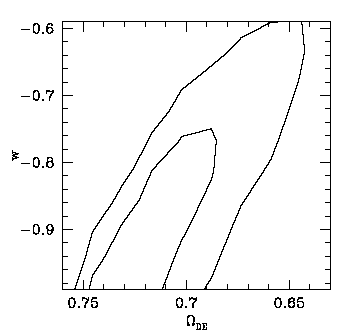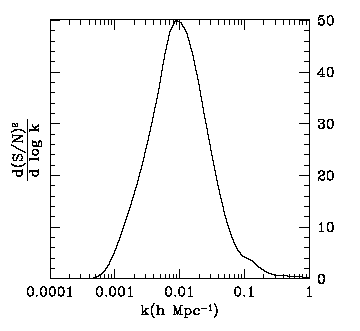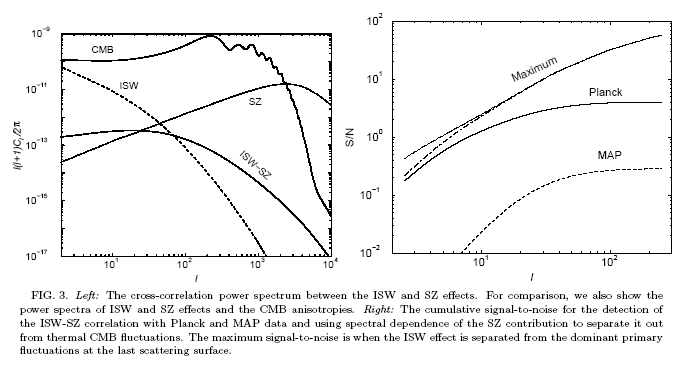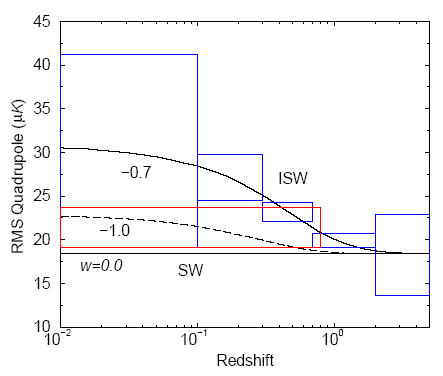Cross-Correlation with Galaxy Surveys
The inherent statistical errors forced upon the ISW effect by cosmic variance at large angular scales severely limits the ability to extract information from it regarding the dark energy. There may be hope yet, however. Recall that we derived the very possibility of the ISW contribution to the CMB from arguments related to the evolution of gravitational potentials Φ associated with large scale structure. Therefore, since the potential Φ is related to the matter distribution via the Poisson equation, tracers of these mass distributions (specific objects chosen to indicate the existence and quantity of large scale structures) will then be correlated with the CMB through the ISW effect. A simplistic yet illustrative interpretation of this is to imagine one map of the sky on which we plot only the ISW contribution to the CMB. Then we take another map on which we have drawn all of the large scale structure within some distance away from us. A correlation between these two maps then means that if we laid one of them directly on top of the other, all of the spots that are drawn on each would line up. Let's see how this actually works in practice.
Cross-Correlation Generally
For completeness, we will follow the derivation of the theoretical expectation value of the cross-correlation of two random fields projected onto the sky by following the derivation in Afshordi et al. (2003).
Given two random fields A(x) and B(x) defined with their Fourier transforms as
![]()
and
![]()
then the cross-correlation power spectrum PAB(k) is given as
![]() .
.
The projections of A and B on the sky are defined using the projection kernels FA and FB (which are merely the anisotropy terms for the given fields) by
![]() ,
,
![]()
So, for the ISW effect, the projection kernel is just
 .
.
However, the projection kernel for the galaxy perturbation is given by

All that is left to do is to expand these relationships onto the spherical sky and make the Limber approximation (see Afshordi et al. 2003 for details). Expanding in spherical harmonics and taking the expectation value gives
![]()
for two arbitrary fields A(x) and B(x). Making the Limber approximation and using the ISW and galaxy kernels as a concrete example of the result gives (from Afshordi, 2004)

as the expected cross-correlation of the ISW effect with a galaxy distribution.
Galaxy Surveys
Perhaps the most obvious tracer of the large-scale structure at low redshifts (recent times) involves the galaxies themselves. Since there are several catalogues of galaxies on hand from various galaxy surveys, this may even seem like an ideal choice. Although very good, the use of galaxies is still not ideal as the problem of cosmic variance will still limit the detection ability of a cross-correlation analysis. To see this, write out the expected dispersion for each CgT(l)
![]()
Clearly, then, at the lowest l, where the ISW effect becomes most important, and therefore most easily detectable, the error associated with each CgT(l) grows. However, as found in Cooray (2001) it is the primary temperature perturbations of the CMB themselves that limit the signal-to-noise for the detection of the ISW-large-scale structure cross-correlation (see figure below).

(Cooray, 2001)
In addition, Afshordi (2004) shows that an optimal ISW-galaxy cross-correlation detection only has the ability to place constraints on the eqn. of state and energy density that are comparable to current bounds on these parameters yet such an observation will be probing our cosmological theories at the largest scales ever tested (see below).


(Afshordi, 2004)
Other Surveys
In addition to the ISW-galaxy cross-correlation signal (e.g. using SDSS or 2MASS) other possibilities are ISW-radio/x-ray source correlation from radio or x-ray surveys (e.g. NVSS or HEAO1 A2), the ISW-Sunyaev-Zel'dovich (SZ) cross-correlation from a dedicated SZ cluster survey, ISW-lensing cross-correlation, or even CMB polarization.
The ISW-radio/x-ray cross-correlation signal tracks the ISW-galaxy signal very closely due to the close relationship of the tracers of the matter distribution.
The ISW-SZ correlation is more complicated. Derived similarly to the ISW-galaxy cross-correlation by Cooray (2001) one obtains the cross-correlation pictured below.

(Cooray, 2001)
As the author notes, an analysis done for the expected Planck sensitivity is limited by the interference of the primary CMB anisotropy itself (an obviously recurring problem). However, a maximum signal-to-noise of ~60 can theoretically be achieved if a method of separating these two signals can be developed, which is of course a very attractive (yet very optimistic) possibility.
For the ISW-lensing correlation measurements, evaluated for expected Planck satellite sensitivity once again, has the ability to achieve signal-to-noise ~10 based on calculations done by Cooray (2001) as well.
A seemingly promising method of pinning down the ISW effect despite the problem of cosmic variance is through the use of CMB polarization towards galaxy clusters. Let us delve into this a bit further.
CMB Polarization Towards Clusters as a Probe of the ISW Effect
(see Kamionkowski & Loeb, 1997 and Cooray & Baumann, 2002)
As we have discussed at length, the limitations placed on observation of the ISW effect by cosmic variance are formidable. Here we will discuss a concept proposed by Kamionkowski & Loeb (1997) and extended by Cooray & Baumann (2002) to use the polarization of the CMB due to a quadrupole anisotropy of the CMB in a plane normal to the line of sight towards a galaxy cluster.
The SZ effect, which we have mentioned but not dwelled upon,
is basically the inverse Compton scattering of CMB photons in the hot gases near some galaxy clusters. However, if this
incoming radiation contains a quadrupole anisotropy in the plane normal to the
line of sight to the cluster then the scattered radiation will be linearly
polarized. By measuring the polarization of the CMB at that cluster what
is essentially being done is measuring two components of the quadrupole of the
CMB at that galaxy (Kamionkowski & Loeb, 1997). So, by using the galaxy to
measure what an observer at that location would measure to be the quadrupole of
the CMB anisotropy, we are really seeing that observer's surface of last
scattering (since these clusters are very distant and thus we are seeing a
younger, and so smaller, last scattering surface). The figure at right
(from Kamionkowski & Loeb, 1997) depicts this situation for varying distances
from us today (in redshift). Due to the distance being traveled by the scattered
and polarized radiation from a distant cluster, and the possibility that the
quadrupole may evolve in time, quadrupole moments that are reconstructed from
such measurements will not decrease the cosmic variance.
photons in the hot gases near some galaxy clusters. However, if this
incoming radiation contains a quadrupole anisotropy in the plane normal to the
line of sight to the cluster then the scattered radiation will be linearly
polarized. By measuring the polarization of the CMB at that cluster what
is essentially being done is measuring two components of the quadrupole of the
CMB at that galaxy (Kamionkowski & Loeb, 1997). So, by using the galaxy to
measure what an observer at that location would measure to be the quadrupole of
the CMB anisotropy, we are really seeing that observer's surface of last
scattering (since these clusters are very distant and thus we are seeing a
younger, and so smaller, last scattering surface). The figure at right
(from Kamionkowski & Loeb, 1997) depicts this situation for varying distances
from us today (in redshift). Due to the distance being traveled by the scattered
and polarized radiation from a distant cluster, and the possibility that the
quadrupole may evolve in time, quadrupole moments that are reconstructed from
such measurements will not decrease the cosmic variance.
What can be done is to map the 3D density field from the measurement of many of these quadrupole moments and therefore probe the quadrupole with independent measurements from distant clusters. This would then allow for a decrease in the cosmic variance in the determination of the quadrupole. The only problem with this scheme is that the polarization associated with a distant galaxy has two distinct mechanisms: the primordial CMB quadrupole, which we are after; and a component due to transverse motion of the cluster.
Fortunately, the two components can (ideally) be distinguished due to their origins (Cooray & Baumann, 2002). The polarization due to the primordial quadrupole of the CMB, PCMB, goes as
PCMB ~ <τ>Qrms
where <τ> is the sample averaged optical depth to scattering and that due to the Doppler effect, PDop, goes as
PDop ~ g(x)<τ><βt2>
where βt = vt/c is the transverse velocity component of the cluster velocity and g(x) the frequency dependence of the kinematic Doppler effect, and is proportional to ν, the frequency. The reason for developing this idea so thoroughly is that PCMB traces the underlying temperature quadrupole but PDop does not. Luckily, PDop<<PCMB even for large ν since
PCMB ~ 4.9τ μK
yet
PDop ~ 0.27g(x)τ[βt▪10-3]2 μK.
The result of this is that with a measurement of the optical depth τ, one can then make a multi-frequency polarization measurement which translates into information on the primordial quadrupole at the location of that cluster. From this, the 3D density field may be reconstructed so that the statistics on the quadrupole may be reduced and a measurement of the rms quadrupole can be obtained to the limits shown in the figure below. That is, one uses the clusters "as a tracer population in which each cluster individually provides information on the rms quadrupole" (Cooray & Baumann, 2002).

(Cooray & Baumann, 2002)
Furthermore, since the quadrupole contains a significant, normally cosmic variance limited, contribution from the ISW effect, an indirect yet precise measurement of the quadrupole at successively deeper redshifts will directly observe this effect. One might then extract information on the equation of state of the dark energy to an uncertainty of ~0.1 (Cooray & Baumann, 2002).
•